The Economic & Geopolitical History of Niger, Part 1: Uranium, Tribalism & Colonialism
"Nigh-Gerr" is how English people say it, "Nee-ghair" is how French people say it
Niger, a landlocked country in West Africa's Sahel region, is predominantly Muslim with 28 million people as of April 2024. A person from Niger is a Nigerien, while a person from Nigeria, is a Nigerian. The capital is Niamey, and the country is larger than Texas and California combined. The country suffers from extreme poverty, ranking as the 7th poorest nation by income per capita and 4th lowest in human development index. 82% of the adult population lack access to basic financial services as of 2023.
Characterized by hot, barren landscapes, its northern regions have low population density. The name "Niger" translates to "the river of rivers" in Tamasheq, spoken by the Berber Tuareg (“TWAH-reg"), who inhabit the Sahara across Southern Algeria & Libya, and northern Mali & Niger. Colonized by the French, most inhabitants reside in the south where grasslands are more prevalent, near the arable land along the Niger River.
Niger shares similarities with Nigeria, such as the Niger River and a sizable Hausa population. Nigeria has a smaller landmass than Niger, yet Nigeria’s population is 7x larger. The average Nigerian makes roughly quadruple the income of the average Nigerien. Despite Nigeria’s challenges, it remains significantly wealthier than Niger, which faces even greater economic struggles. The income gap underscores this contrast:

Why is that? Well being landlocked has in part to do with it. Let’s look at Niger on a map.
Being landlocked is terrible for Niger. Having no ports severely restricts Niger's global trade access. While the Niger River allows small ships, larger vessels cannot navigate the Niger Delta to reach the Atlantic Ocean. Consequently, goods transported along the river must be unloaded, trucked, and reloaded onto ocean-going ships, adding costs and delays. This makes imports expensive and exports challenging, limiting Niger's trade to high-value resources. Niger relies on its neighbors Nigeria and Benin for international trade. Nigeria & Benin collect tariffs, customs duties, port fees, transit taxes, from Nigerien trade. Niger also relies on Nigeria for electricity (and Nigeria struggles providing itself electricity).
Niger has a very young populace; the average age is around 14 to 15 years old as of 2024. This Sahelian country has historically been populated by Hausa, Fulani, Tuareg, Songhai, and etc. This country is an entirely a fabrication of colonial borderlines, there was never a country called Niger before colonialism. The Hausa & Fulani also live in northern Nigeria, the Tubu also live in Libya and Chad, and the Tuareg also live in Libya, Mali, and Algeria.
Over 70% of Nigeriens are animal herders or subsistence farmers, with arming yields lower than the African average, categorizing it as a “net food importing developing country”.
As of 2024, the country has requested 13 IMF Bailouts since independence. This indicates that Niger has chronic current account deficit issues, importing significantly more goods & services than Niger exports or collects in remittances or aid, draining its foreign currency reserves. Foreign currency is needed to buy food/fuel/medicine due to insufficient domestic production. In 2022, Niger’s current account was -$2.3 Billion.
Niger has only ran a current account surplus in two years - 1975 and 1984, every other year it has run a deficit.
Adjusted for inflation, Niger, like its neighbor Chad, is poorer than it was at independence.
Niger, akin to Chad, endured neglect during colonial rule, with its people coerced into peanut farming under threat of violence. It wasn't until the late 1950s that France discovered uranium, though extraction didn't commence until the 1970s. The 1970s saw a boom in uranium production, benefiting Niger until the 1980s. However, the subsequent international commodity price slump adversely affected African economies, including Niger's. The 1990s brought Tuareg Berber rebellion in the north, stalling growth until the 2000s, when China's demand for commodities sparked another boom. This period ended in 2015 as China's imports slowed. Refer to the chart below for Nigerien income trends.

Given Niger's abundant uranium deposits, a common question is why it remains impoverished.
Why is Niger poor despite having Uranium?
Uranium is a great resource. If we compare to other resources, solar and wind need sunlight and airflow. A dark, still sky means no electricity from these resources, meaning backups like batteries or fossil fuels is needed. Also, we all know fossil fuels cause climate change, while uranium doesn’t emit carbon. So why isn’t uranium lucrative?
First let’s look at Niger in the uranium market.
Whenever you want to look at an economies’ resource strength in a commodity, you need to look at reserves, production, and exports.
Reserves
Niger possesses vast uranium reserves, totaling 277,000 tons, ranking 8th globally. This constitutes 5% of humanity's known uranium reserves, primarily concentrated in Agadez region.
Production
In terms of uranium production, Niger is 6th in the world as of 2023, losing to Kazakhstan, Australia, Namibia, Canada, and Uzbekistan.
Niger ranks 6th globally in uranium exports, trailing behind major natural uranium exporters such as Kazakhstan, Canada, Namibia, Australia, and Uzbekistan, along with countries like France, which source uranium from Niger. In 2022, Niger's export revenue amounted to just $150M.
Now let’s talk about why uranium isn’t making Niger rich.
#1: Low Human Capital
Niger has one of the world's lowest literacy rates, with only 37% adult literacy, and girls attend school less frequently than boys. Then an even much lower proportion are nuclear engineers, operator, and scientists. The country does joint ventures with multinational energy companies for uranium extraction, via the joint ventures(JV), Nigeriens learn how to manage, operate, and run a uranium mine through the JVs. Below you will see all the joint ventures the Nigerien government has with other companies just to pick up uranium rocks. The Nigerien government takes minority ownership stake (20% to 37%), while the foreign firm provides the workforce, capital, and know-how to extract the rocks. Three of these mines are majority owned by the French firm Orano, and Spanish, British, Canadian, Chinese, and South Korean firms are also involved in Niger’s uranium extraction.
#2: Selling Uranium rocks isn’t lucrative compared to other commodities.
Uranium isn’t a lucrative market. Kazakhstan sold nearly half of all uranium in 2022. That was only $2.6B. Meanwhile, United Arab Emirates sold 7% of all crude oil in 2022. That amounted to $105B for the Emiratis.
Contrary to common misconceptions, not all resource trades are equal in demand. Let's contrast the uranium trade with other fossil fuels.
As you can see, uranium simply isn’t in demand as much as other fossil fuels. Uranium alone won’t make Niger like Qatar.
Oil trade in 2022: $1.45 Trillion, the top 3 biggest buyers were the European Union purchasing $326B, China buying $287B, and U.S. buying $199B.
Natural Gas trade in 2022: $827 Billion, the top 3 biggest buyers were the European Union purchasing $390B, China buying $73B, and Japan buying $64B.
Coal trade in 2022: $283 Billion, the top 3 buyers were India at $59B, Japan at $54B, and the EU at $40B.
Uranium trade in 2022: ~$6Billion
The biggest buyers of Uranium were the EU: $1.82B, China: $1.26B, and Canada: $1.05B.
Even if you look over time, fossil fuels have always been traded more than uranium. (Look at Uranium in green)

The next question you are probably asking is why isn’t uranium traded as much as fossil fuels? I’ll give three.
#1: Lobbying groups fund anti-nuclear movements: Many oppose nuclear energy. Fossil fuel lobbyists contribute to this by funding anti-nuclear activism. Despite valid concerns like the Fukushima incident, nuclear energy remains a viable option, as evidenced by France's reliance on it for 70% of its energy.
#2: Recycled fuel serves as an alternative to purchasing new uranium.: Nuclear fuel is recyclable, unlike oil or gas. Countries like France, Russia, China, and Japan reprocess used nuclear fuel, reducing the need for constant massive purchases. France’s state owned nuclear giant Orano buys new uranium from Niger and reprocesses old uranium. This contrasts with the EU's significant spending on natural gas compared to uranium.
#3: Many countries think Nuclear energy is unsafe: Many countries are anti-nuclear energy, especially after the Three Mile Island Incident in 1979 in US, the Chernobyl incident in Soviet Ukraine in 1986, and the Fukushima incident in Japan in 2011. (The death count for all three events is 31 people). Germany, Japan, Italy, Lithuania, Portugal, Denmark, and Austria then either halted building new facilities, built harsh barriers to make it hard to build a plant, or shut down existing plants.
Frankly, Niger would be significantly richer if people bought uranium like they bought oil, gas, or coal.
Does France Depend on Nigerien Uranium?
I would say, in the past yes, but not anymore.
France has 56 nuclear reactors in its 18 power plants. Until China came along in the mid 2000s, France's state-owned nuclear firm, Orano (and its subsidiary Areva), held a near monopoly on uranium mining in Niger, managing exploration, extraction, processing, and site restoration. Areva also operates in Canada and Kazakhstan.
While France once heavily relied on cheap Nigerien uranium (Niger used to have low royalty fees of 5%, similar to Australia), this dependence has decreased.
In 1991, Soviet Union collapsed into 15 separate countries each with rich uranium reserves of their own (i.e. Russia, Kazakhstan, Kyrgyzstan, & Uzbekistan). Then these nations had their firms join the international commodity markets, giving France new sources of uranium.
Niger raised its uranium royalties in 2006 ( 12% to 15%, similar to Canada, but still lower than Kazakhstan), prompting Orano to diversify its sources, notably investing in Kazakhstan. As of 2022, Kazakhstan is France's primary uranium supplier, and Niger is second with Uzbekistan at a close 3rd. I find this ironic since Kazakhstan has more expensive royalty fees (18%) than Niger has.
The EU's nuclear agency, Euratom, assures that Europe's nuclear energy supply would not be disrupted even if Niger ceased uranium exports, as other countries like Kazakhstan, Australia, Uzbekistan, Namibia, or Canada could fill the gap.
Niger’s Economic Complexity
What’s funny is that I have spoken so much about Uranium, but Uranium isn’t even Niger’s biggest export anymore. It’s gold now.

Initially, Niger's main export was selling nuts. Then in 1970s, uranium became the primary export after France mined huge deposits. By 2018, gold replaced uranium. As always, being a commodity exporter means that the country lives and dies by the global commodity price.
Is gold a good commodity to depend on?
Its a bigger market than coal & uranium combined, but Niger only sells a few billion in gold legally. How? Well, Niger, just like most of West Africa, has a gold smuggling problem. How can we tell? Discrepancies between UAE's reported gold imports from Niger and Niger's reported gold exports to UAE reveal extensive illegal gold laundering by African artisanal miners to evade taxes, fees, and customs duties. This undermines the African government’s effort to effectively regulate the gold market and collect revenues. UAE is intensifying efforts to crack down on illegal gold smuggling, but in reality, this is a state capacity problem of Niger.
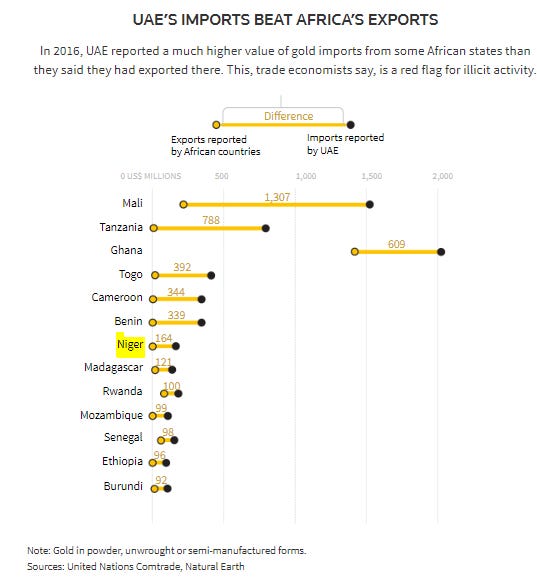
Gold smuggling deprives African countries of vital foreign currency. If the money received isn’t held in an African bank, then the West African central bank isn’t building reserves. Mauritania is one of the few African countries that has relatively good mining regulation which benefits all stakeholders.
Pre-Colonialism
Niger is so artificial we need to delve deep in the pre-colonial history.
Nomadic Berbers inhabited the desert north, while agriculturalists lived in the south. Niger comprised five main conquered groups: the Hausa, Fulani, Zarma-Songhai, Kanuri, and the Tuareg. There is also a very small Arab minority and many other tribes.
Eastern Niger was influenced by the Kanem-Bornu empire, dominated by the Kanuri. If you’d like to know more about Kanem-Bornu, you can read my article on Chad.
The Hausa, constituting over half of the Nigerien population. They initially formed city-states in the 14th century AD in Southern Niger & Northern Nigeria. They were later conquered by the Songhai before gaining freedom. Then they engaged in conflicts and trade with various tribes, including the Tuaregs and Kanem-Bornu, until they were conquered by the Fulani Sokoto Caliphate, and were then divided in British Nigeria and French Niger.
Songhai Empire (1430s-1591)
Originating from East Mali/Western Niger, the Songhai were part of the larger Mali empire, which spanned Senegal, Gambia, Guinea, Mali, Mauritania, and Northern Burkina Faso.
The Songhai conquered the Mali empire and expanded their territory, ruling over Central & Western Niger, Southern Senegal, Gambia, most of Guinea, south Mauritania, most of Mali, upper Burkina Faso, northern Benin, and Northern Nigeria.
The Songhai Empire was crushed by Saadi dynasty of Morocco in the Battle of Tondibi in 1591.
Tuareg
Fourthly, the Tuareg, nomadic Berbers, inhabited Upper Niger and neighboring regions (Algeria, Libya, Mali, and northern Burkina Faso). They acted as intermediaries, facilitating trade of black slaves, ivory, salt, and gold to North Africa.
Tuaregs are intermediary between Arab-Berber North Africans and Black Africans. They are darker-skinned Berbers/Amazighs and have rebelled numerous times in Mali and Niger to establish their own state.
Tuareg rebellion stems from their historical autonomy, particularly the Sultanate of Agadez in Northern Niger (1449-1900). This state, located in the Aïr mountains, was a blend of Berber Tuaregs and some Black Hausas.
Agadez was briefly conquered by the Songhai Empire in the 1500s, then came under Moroccan control after the Battle of Tonbibi in 1591, when the Moroccans destroyed the Songhai Empire. Morocco lost control eventually, and the Agadez remained nominally independent until the arrival of the French.
The Tuareg Berbers, Songhai, and Kanuri prospered through the Trans-Saharan trade, dealing in gold, salt, leather, and slaves from pagan African tribes, and selling them to North African Berbers. However, with the rise of the Trans-Atlantic and Indian Ocean slave trades, demand shifted away from the Trans-Saharan route, leading to the decline of these empires.
The Fulani
In the early 1800s, the Fulani-established Sokoto Caliphate became dominant in West Africa, establishing a formidable slave state.
The Fulanis conquered the Tuaregs and Hausas.
The Caliphate was so vast that the Fulani conquered parts of modern-day Burkina Faso, Benin, Niger, Cameroon, and Nigeria.
Slavery under the Sokoto Caliphate was based on religion rather than race (since everyone was black), with over 50% of the population enslaved. While Fulani’s pagan slaves had certain rights such as property ownership and pay with their master's permission, they were still subject to brutal oppression, forced army subscription, plantation work, and ownership by their masters. But, Fulani slavery had manumission clauses.
Both Britain and France subdued the Sokoto Caliphate and other empires in the region, and then created new countries out of thin air. The amalgamation of the Songhai, Tuaregs, Hausa, Fulani, and others created the French colony of Niger, and the amalgamation of Hausa, Fulani, Edo, Igbo, Ibibio, Yoruba, and others became British Nigeria.
The complete conquer and creation of Niger was brutal.
The Voulet-Chanoine (Voo-lay Sha-nwahn) Mission stands out as one of the worst colonial massacres in Niger. French officials Voulet and Chanoine, along with their Senegalese and Algerian soldiers, massacred over ten thousand people in Birni-N'Konni (Beer-nee N'koh-nee), marking a tragic episode of colonial violence.
French Niger (1902-1960)
Niger was part of French West Africa, which included Benin, Burkina Faso, Ivory Coast, Guinea, Mali, Senegal, and Togo, with Dakar, Senegal serving as its headquarters. Niger was sparsely populated with a population of 1.3M in the 1900s.
The colonial borders of Niger underwent several changes: first as "Senegambia & Niger" (1902-1904), then "Upper Senegal and Niger" (1904-1921), and finally, it became simply Niger by 1922.
France ruled Niger indirectly through French appointed tribal leaders overseen by a governor. The Tuareg Berbers strongly opposed French rule, rebelling in 1916 and again in 1922.
Forced labor was imposed on Africans for infrastructure projects and peanut exports. Peoples homes were burned, and people were tortured for resisting. After World War II, France abolished forced labor, increased education spending, and granted African representation in the French Parliament. Hamani Diori, a Songhai ethnic, became the elected representative for Nigeriens.
Why the Songhai? The Songhai-Zarma tribe had the most “amicable” relationship with France, being considered "évolué" or evolved Africans who embraced French values. Unlike most Africans in Niger, they were open to assimilation into French culture.
In the 1950s, France sought mineral resources in Niger. In the 1950s, Niger remained heavily subsidized and unprofitable compared to other colonies like Senegal, Gabon, and Ivory Coast within French West Africa. France felt that they had to find minerals in Niger to make their colonization “worth it”. Even by 1953, Niger was poorer than Vietnam, which was being bombed by France for seeking independence.
Geologists discovered uranium in the Agadez region, and further deposits were found in Arlit, Akokan, Azelik, Madeouela, and Imouraren by the French Atomic Commission and the Bureau of Geological and Mining Research. However, due to lengthy excavation processes, none of these deposits were exploited until after Nigerien independence.
Pre-independence, two main parties emerged: the Pro-French faction, led by French representative Hamani Diori, who represented the Nigerien Progressive Party. Diori’s party was full of Songhai-Zarma ethnics.
The other party was the Sawaba movement, led by Djibo Bakari, advocated for Niger to break away from French influence and align with the Soviet and Maoist camp, influenced by Chinese revolutionary socialism.
In the 1958 referendum, both sides campaigned vigorously. Hamani Diori, akin to other Francophile leaders like Leon M’ba of Gabon, Felix Houphouët Boigny of Ivory Coast, and Leopold Senghor of Senegal, supported maintaining ties with France. Conversely, Sawaba sought independence.
Ultimately, 78% of Nigeriens voted to remain pro-French, while 22% supported the anti-French Sawaba movement. Guinea was the only country in French West Africa to opt for independence.
In the 1958 elections, Hamani Diori's party overwhelmingly defeated Sawaba, winning 49 seats to Sawaba's 11. France subsequently banned Sawaba.
In 1959, assassins from the banned Sawaba attempted to kill Diori, viewing him as a neocolonial puppet of France, and a person who looks out only Songhai people. Following the assassination attempt, Diori pursued measures against the Sawaba movement and doubled down on Songhai favoritism, which isolated 70% of the population.
Before Nigerien independence, there was already tribalism, distrust, and ethnic favoritism. Can Diori over come this? Next time, we'll explore Diori's presidency and successive Presidents when we discuss an independent Niger in 1960. Click here for Part II.


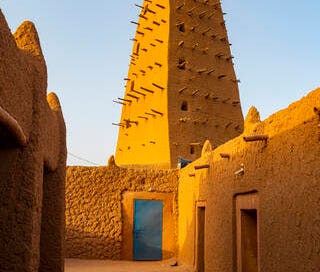










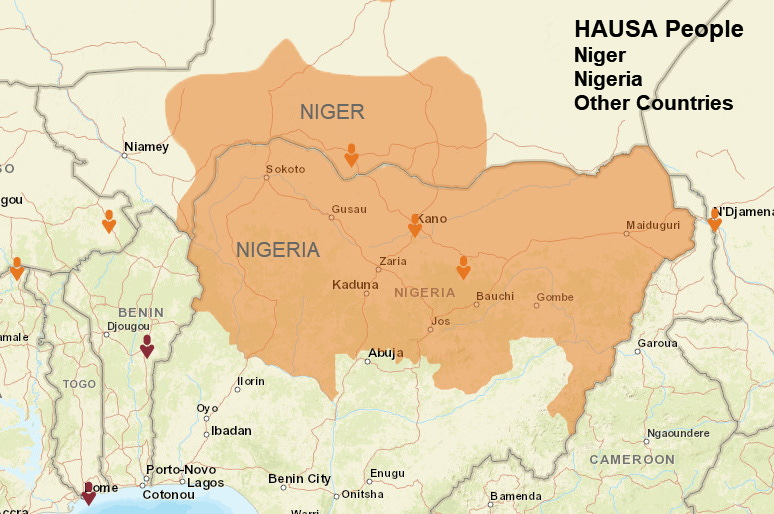



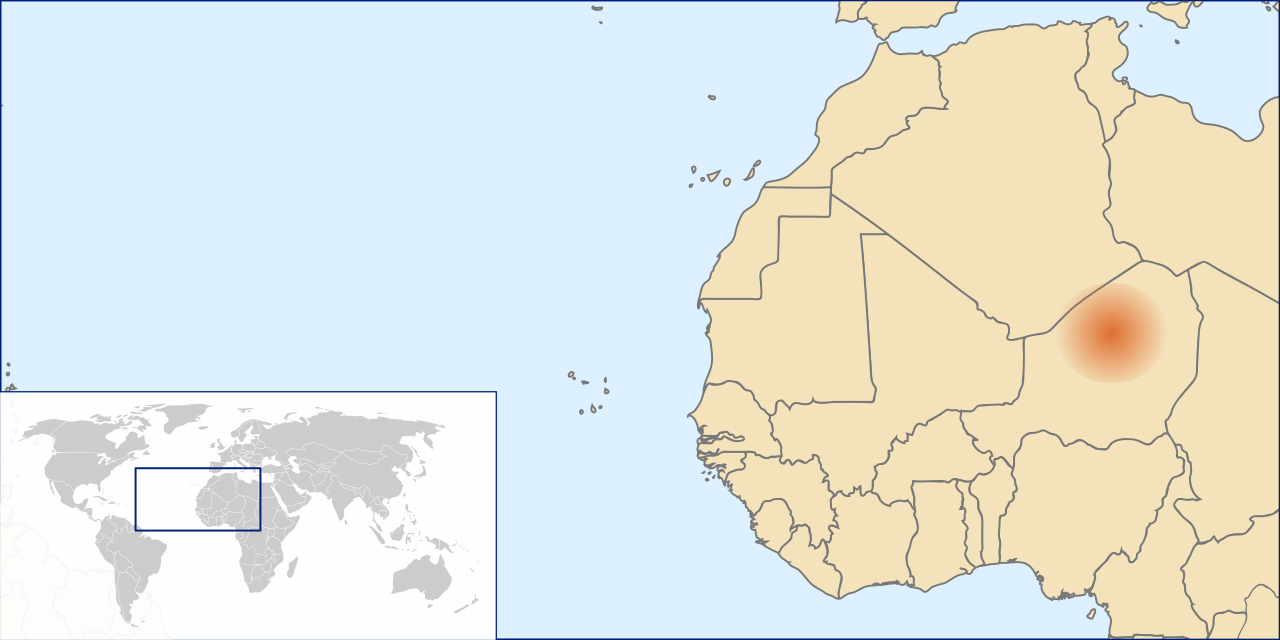




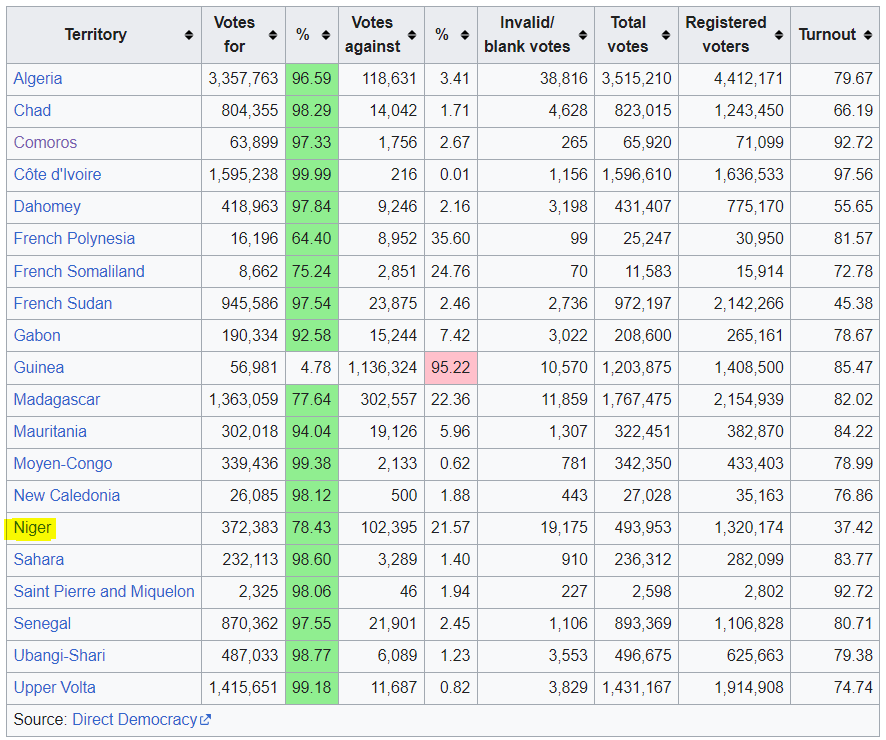

Something I don't understand. The Mali were trading slaves through the northern trans-Saharan route before the Europeans arrived seeking gold and slaves. Why didn't the Songhai (who were at the height of their power in the 16th cent) not take advantage of rising European demand for slaves at the time? And what was going on in the region between 1591 and the early 1800's?
From what I understand, more and more textile products are being transported via air freight due to falling costs. Do you think some moderate investment in airports specialised for cargo handling will enable some landlocked African countries to get their taste of industrialisation? Other textiles what other products (manufactured or otherwise) are being transported via air freight and what products will join the air freight club in the future as costs continue to fall?